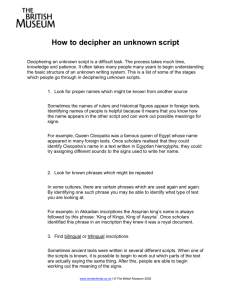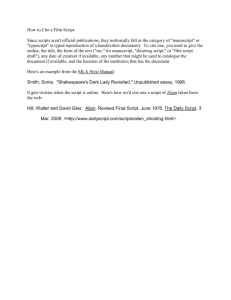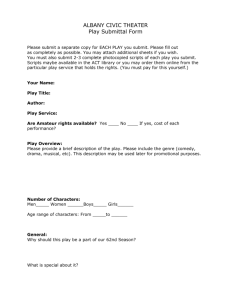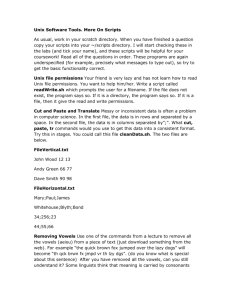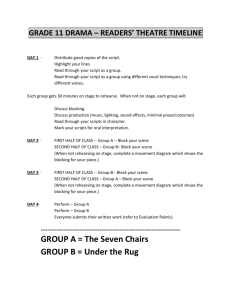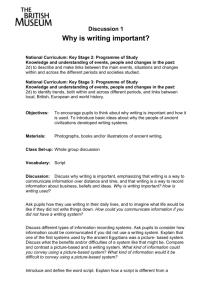The Future of Knowledge Management
advertisement
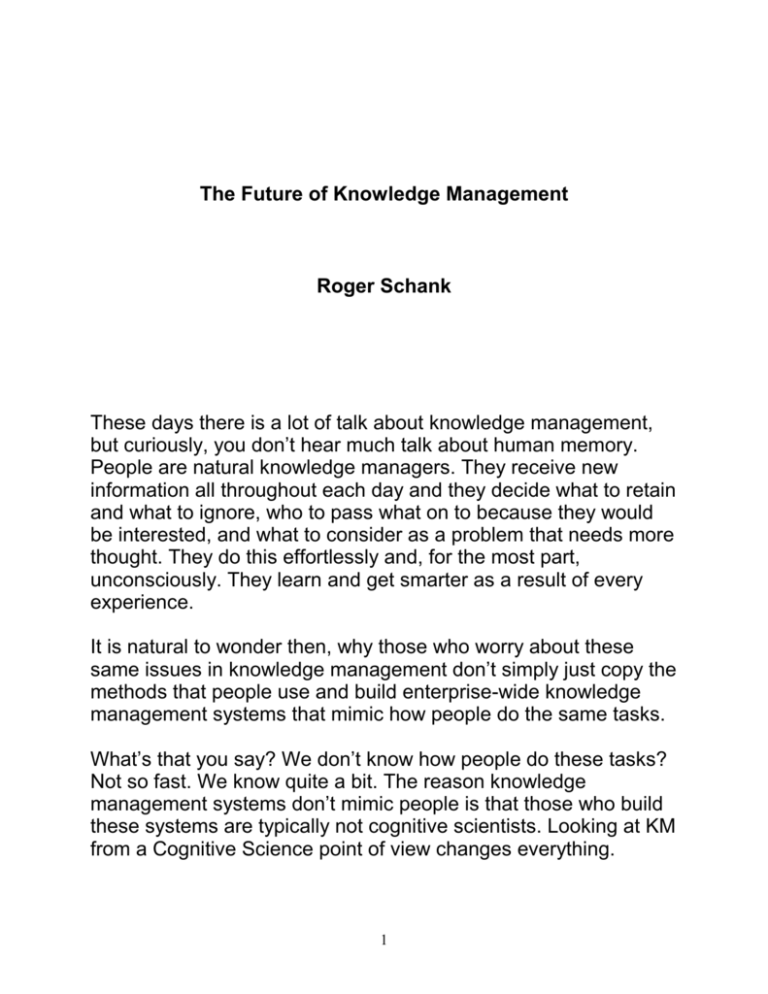
The Future of Knowledge Management Roger Schank These days there is a lot of talk about knowledge management, but curiously, you don’t hear much talk about human memory. People are natural knowledge managers. They receive new information all throughout each day and they decide what to retain and what to ignore, who to pass what on to because they would be interested, and what to consider as a problem that needs more thought. They do this effortlessly and, for the most part, unconsciously. They learn and get smarter as a result of every experience. It is natural to wonder then, why those who worry about these same issues in knowledge management don’t simply just copy the methods that people use and build enterprise-wide knowledge management systems that mimic how people do the same tasks. What’s that you say? We don’t know how people do these tasks? Not so fast. We know quite a bit. The reason knowledge management systems don’t mimic people is that those who build these systems are typically not cognitive scientists. Looking at KM from a Cognitive Science point of view changes everything. 1 Today, knowledge management systems store knowledge about manuals and procedures the way a library catalog system does the same job. They use an initial set of categories, to describe the domain of knowledge. Such a static system changes with great difficulty. Once you have designed it, it never really changes. More importantly, changing it requires outside intervention, maybe a committee and a total re-design. Why does the ability to change how knowledge is indexed matter? It is called learning. If a person doesn’t get smarter as a result of experience he is called dumb. A KM system simply gets slower as a result of more information. It never has an aha experience, recognizing how two different documents considered together can shed a whole new light on an issue. It never has that experience because it actually understands nothing about what these documents contain. It is like a librarian who can’t read. We can do better. Let’s look at people. Human experts do not have static memories. They can change their internal classification systems when their conception of something changes, or when their needs for retrieval changes. People change their focus or their interests and the things they think about and remember change as well. For the most part, such changes are not conscious. People do not typically know the internal categorization scheme that they use. They can do this without even realizing they have done it. This is what a dynamic memory is all about – getting smarter over time without realizing it. The acquisition of new knowledge actually makes experts smarter, while it often just makes knowledge management (KM) systems slower. People seem to be able to cope with new information with ease. We can readily find a place to store new information in our 2 memories, although we don’t know where or what that location is. This is all handled unconsciously. We can also find old information, but again we don’t know where we found it and we can't really say what the look-up procedure might have been. Our memories change dynamically in the way they store information by abstracting significant generalizations from our experiences and storing the exceptions to those generalizations. As we have more experiences, we alter our generalizations and categorizations of information to meet our current needs and account for our new experiences. Despite constant changes in organization, we continue to be able to call up relevant memories without consciously considering where we have stored them. People are not aware of their own internal categorization schemes -- they are just capable of using them. The question for KM is how to make systems more like those of people. Human memories dynamically adjust to reflect new experiences. A dynamic memory is one that can change its own organization when new experiences demand it. A dynamic memory is by nature a learning system. No KM system learns. But they need to learn in order to actually work properly. The underlying question is how knowledge is structured. People structure knowledge when they build any KM system by inventing a set of categories to put documents in. But, what categories do people use inside their own heads? People use knowledge structures, ways of organizing information into a coherent whole, in order to process what goes on around them. Knowledge structures help us make sense of the world around us. What knowledge structures does an expert have and how do they acquire them? 3 Understanding how knowledge structures are acquired helps us understand what kinds of entities they are. Learning depends upon knowledge and knowledge depends upon learning. I have discussed scripts many times over the years. A script is a simple knowledge structure that organizes knowledge we all know about event sequences in situations like restaurants, air travel, hotel check in, and so on. We know what to expect and interpret events in light of our expectations. But do we use this kind of structure to manage knowledge? If something odd happens to us in a restaurant, how do we recall it later? Let me count the ways. We would recall it if we entered the same restaurant at another time or if we had the same waitress at a different restaurant, or if we ate with the same dinner companions (assuming we ate with them rarely.) It is clear that an incident in memory is indexed in many ways. One set of indices is the “people, props and places” that appeared in an incident and are associated specifically with that incident. But there is more abstract indexing method that goes beyond the “people, props, and places” type of index. Those indices are about actions, results of actions, and lessons learned from actions. These indices matter greatly in a KM system. If they do not exist no one will learn anything from a description of an event that has lessons in it beyond those about the people and places of that event. One set of abstractions about actions involves roles and tasks. Organizing information around role and tasks allows events to be easily accessed if one has an implicit understanding of the roles and tasks involved in a given situation. Beyond using an organizational scheme involving roles and tasks, human experts can do something that is quite significant. They can abstract up a level to organize information around plans and goals. To put this another way, if the waitress dumped spaghetti 4 on the head of someone who offended her, you should get reminded of that event by the 3 Ps and also if you should happen to witness this event in some other setting. But, far more importantly, you should get reminded of this event if you witness the SAME KIND OF EVENT another time. The question is what does it mean to be the same kind of event? Whatever this means, it would mean different things to different people. One person might see it as an instance of “female rage” and another as an instance of “justifiable retribution.” Another might see it as a kind of art. The key issue is to learn from it. Any learning that takes place involves placing the new memory in a place in memory whereby it adds to and expands upon what is already in that place. So, it might tell us more about that waitress, or waitresses in general, or women in general, or about that restaurant and so on, depending upon what we previously believed to be true of all those things. New events modify existing beliefs by adding data to what we already know or by contradicting what we already know and forcing us to new conclusions. Either way, learning is more than simply adding new information. Since information helps us form a point of view, when we add new information it changes the information we already have. The question is: how do we find the information we already have? This answer depends upon how it was indexed (or categorized) in the first place. Learning depends upon the initial categorization of what we know and may involve changing those categorizations in order to get smarter. A KM system that does not do this will never be very smart and will fail to absorb new information in significant ways. What are the knowledge structures that human memory uses? Higher level knowledge structures, about more complex issues than those dealt with by scripts, hinge upon the notion of abstraction and generalization. Scripts are specific sets of 5 information associated with specific situations that frequently repeat themselves. Scripts are a source of information, naturally acquired by having undergone an experience many times, yielding the notion of a script as a very specific set of sequential facts about a very specific situation. Scripts allow one to organize low level sequential knowledge in a KM. Higher level, more abstract notions, enable learning because they allow sharing of knowledge across script boundaries. Consider “fixing something.” Is this a script? Not really. There might be many scripts each dependent upon what you are fixing. But, if we treat each instance of fixing something as different from every other one, how will we get smarter as a result of having fixed something when we encounter something different that has to be fixed? It is reasonable to assume that people who fix things do get smarter about the process each time. They learn. The question is “how?” In any knowledge-based understanding system, any given set of materials can be stored in either a script-organized or plan/goalbased form. If we choose to give up generalizability, then we can use a script based organization for a KM system. This is more efficient in the short term. Knowing a great deal about a discrete set of roles and tasks in a human organization is a good way to organize information within that organization. But information organized by scripts never transcends the boundaries of those scripts. Any knowing system must be able to know a great deal about one script without losing the power to apply generalizations drawn from that knowledge to a different set of issues within the system. A script, and any other memory structure, should be part of a dynamic memory, changeable as a result of incorporating new experiences. Any structure proposed for organizing information within a KM must be capable of self-modification. Such 6 modification comes about as a result of new events differing in some way from the normative events that a script describes. When new information is placed in a dynamically organized KM, if that information simply amplifies or clarifies the script to which it belongs, then it is simply added to it. On the other hand, when a new event modifies the script, its difference must be noted. And its difference must be applied to all structures to which it is relevant. By utilizing general structures to encode what we know in memory, a system can learn. Given enough modifications from a script, an intelligent system would begin to create new general structures that account for those differences. That is, just because an episode is new once, it does not follow that it should be seen as forever new. Eventually we will recognize what was once novel as “old hat.” To do this, we must be constantly modifying our general structures, which, as we have said, is what we mean by a dynamic memory. All this depends on detailed information, like scripts, that describe the processes in a situation. To put this another way, there cannot be, at least for quiet some time, generalized KM systems that work for every industry or every enterprise. The backbone of intelligence is knowledge of situations. You don’t ask a novice to captain a ship, nor do you ask a beginning salesman to call on your biggest account. An organization knows quite a bit about the processes involved in these situations. We can say what a ship captain does, not simply, but we can say it. And, we can say what a salesman does. Further we can say the experiences a company has had with selling into a particular company or with a particular client or with clients who are like a prospective client. There is a lot of knowledge in an enterprise that can be used to organize new knowledge that is coming in. People understand new knowledge in terms of what they already know. A smart KM 7 system must know a lot of about an industry and a particular enterprise before it starts up. This is hard but by no means impossible. And it is the future of software – namely software that really knows a great deal about your business. Simply put, any business could use someone who knew all about every job, and every person doing that job and every experience the company had had in the past and what its goals and plans were at the moment and could use all that knowledge to know what to do with new information it has just received. That senior citizen of the company used to exist, and he can exist again. Only this time he will be a computer equipped with a very new kind of KM system one that is not about document retrieval but about delivering just in time advice to those who need it. 8
